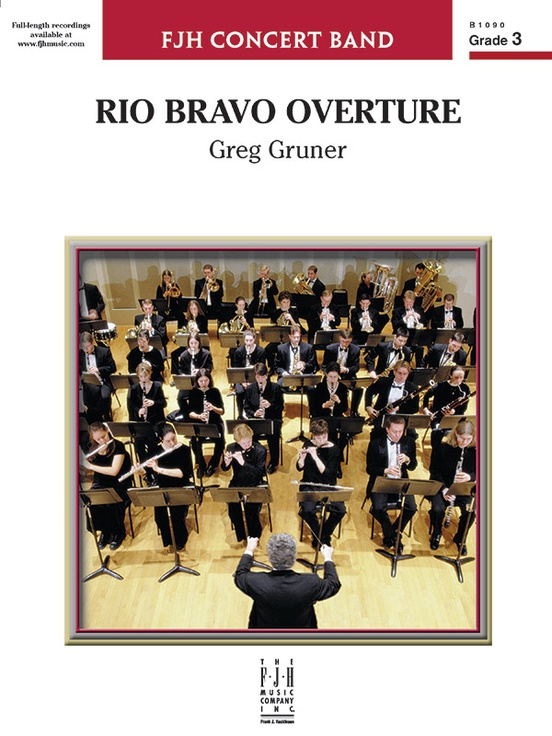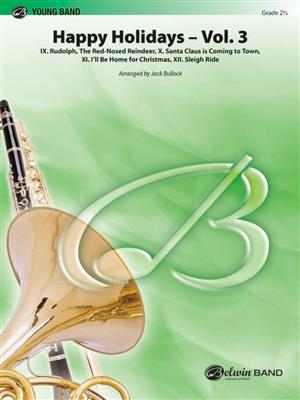Results
-
 £50.50
£50.50Rio Bravo Overture - Greg Gruner
Here's an exciting overture with a wonderful western flavor. It's energetic with a driving and pulsating beat, and also features a memorable lyrical line set in lush harmonies. This will be a real winner at contest or festival. Fun to play and highly recommended! (4:30)
Estimated dispatch 3-5 working days
-
 £64.50
£64.50Happy Holidays - Vol. 3
The third installment in the wildly versatile series, the suite includes Rudolph, the Red-Nosed Reindeer, Santa Claus Is Coming to Town, I'll Be Home for Christmas, and Sleigh Ride. Playable year after year using quintets, woodwind or brass ensembles, or full concert band. Adding this volume, there are now 12 holiday classics available for the ultimate in flexibility while programming your holiday concert. Also available: Vol. 1 (00-42178) and Vol. 2 (00-43107). Bravo! (7:00)
Estimated dispatch 7-14 working days
-
 £80.95
£80.95Panopticon Rising - Ralph Ford
The title implies "all watching," hinting to the mythological Greek Watchman Panoptes and "opticon" for watching. This original contemporary composition opens with an unassuming docile theme. The transparency is rapidly replaced with driving tutti components that furiously depict a vividly punctuated theme. Reminiscent passive melodies interrupt occasionally, building to an uncompromising conclusion. With a vivid percussion contribution, this energy-packed composition is unparalleled. Bravo! (5:30)
Estimated dispatch 7-14 working days
-
 £58.50
£58.50Sousa Classics - John Philip Sousa
Written for the Young Band series and arranged by Victor Lpez, this piece features "El Capitan," "The Liberty Bell," "The Washington Post March," and "The Stars and Stripes Forever"four trio sections of John Philip Sousa's greatest marches. You can never go wrong with a march, and this dynamic arrangement has four of Sousa's best. Bravo! (2:30)
Estimated dispatch 7-14 working days
-
 £144.99
£144.99Gloriosa - Symphonic Poem for Band Movement 1 - Yasuhide Ito
A new acquisition by Bravo Music, this fresh printing of the 1990 masterwork by Yasuhide Ito features a newly engraved score, improved parts, good availability and value. This stirring and powerful homage to early Christianity in Japan profoundly andeloquently states the case of cross-cultural conflict and resolution.I. OratioThe Gregorian chant "Gloriosa" begins with the words, "O gloriosa Domina excelsa super sidera que te creavit provide lactasti sacro ubere." The first movement Oratio opens with bells sounding the hymn's initial phrases. The movement as a whole evokesthe fervent prayers and suffering of the Crypto-Christians.II. CantusIII. Dies FestusCommissioned in 1989 and premiered in 1990 by the Sasebo Band of the Maritime Self-Defense Force of Kyushu, southern Japan.Gloriosa is inspired by the songs of the Kakure-Kirishitan (Crypto-Christians) of Kyushu who continued to practice their faith surreptitiously after the ban of Christianity, which had been introduced to that southern region in the mid-16th century byRoman Catholic missionary Francisco Xavier. The worship brought with it a variety of western music.
Estimated dispatch 7-14 working days
-
£144.99
Gloriosa - Symphonic Poem for Band Mvt 2 & 3 - Yasuhide Ito
A new acquisition by Bravo Music, this fresh printing of the 1990 masterwork by Yasuhide Ito features a newly engraved score, improved parts, good availability and value. This stirring and powerful homage to early Christianity in Japan profoundly andeloquently states the case of cross-cultural conflict and resolution.I. OratioII. CantusThe second movement, Cantus showcases a brilliant blend of Gregorian chant and Japanese elements by opening with a solo passage for the ryuteki, a type of flute. The theme is based on San Juan-sama no Uta (The Song of Saint John), a 17th-century songcommemorating the "Great Martyrdom of Nagasaki" where a number of Kyushu Christians were killed in 1622.III. Dies FestusThe third and final movement, Dies Festus, takes as its theme the Nagasaki folk song, Nagasaki Bura Bura Bushi, where many Crypto-Christians lived.Commissioned in 1989 and premiered in 1990 by the Sasebo Band of the Maritime Self-Defense Force of Kyushu, southern Japan.Gloriosa is inspired by the songs of the Kakure-Kirishitan (Crypto-Christians) of Kyushu who continued to practice their faith surreptitiously after the ban of Christianity, which had been introduced to that southern region in the mid-16th century byRoman Catholic missionary Francisco Xavier. The worship brought with it a variety of western music.
Estimated dispatch 7-14 working days
-
£122.50
Western Graffiti
Western Graffiti is a revue of five famous western melodies and features The Comancheros from the John Wayne film by the same name, Wandrin' Star, the massive hit from Lee Marvin's musical Paint Your Wagon, the legendary theme song from Bonanza, as well as My Rifle, My Pony and Me from Rio Bravo, featuring Dean Martin and Ricky Nelson, and last, but not least, High Noon, from the all-time movie classic of the same name!
Estimated dispatch 7-14 working days
-
 £84.50
£84.50Ghost Dances - Roland Barrett
Inspired by the tragic score of the Lakota Sioux massacre at Wounded Knee in 1890, this dynamic Roland Barrett original work is contemporary, featuring aleatoric musical fragments, and exceeds the bounds of an ultra-emotional musical presentation. Bravo! (6:45) This title is available in SmartMusic.
Estimated dispatch 7-14 working days
-
 £267.50
£267.50Gloriosa - Symphonic Poem for Band (Complete) - Yasuhide Ito
A new acquisition by Bravo Music, this fresh printing of the 1990 masterwork by Yasuhide Ito features a newly engraved score, improved parts, good availability and value. This stirring and powerful homage to early Christianity in Japan profoundly andeloquently states the case of cross-cultural conflict and resolution.Commissioned in 1989 and premiered in 1990 by the Sasebo Band of the Maritime Self-Defense Force of Kyushu, southern Japan.Gloriosa is inspired by the songs of the Kakure-Kirishitan (Crypto-Christians) of Kyushu who continued to practice their faith surreptitiously after the ban of Christianity, which had been introduced to that southern region in the mid-16th century byRoman Catholic missionary Francisco Xavier. The worship brought with it a variety of western music.Though Christianity was proscribed in 1612 by authority of the Tokugawa Shogunate in Edo (today Tokyo), Kakure-Kirishitan continued advocating sermons and disguised songs. Melodies and lyrics such as Gregorian chant were obliged to be "Japanized".For example, the Latin word "Gloriosa" was changed to "Gururiyoza." This adaptation of liturgy for survival inspired Ito to write this piece in order to reveal and solve this unique cultural mystery.The composer explains:"Nagasaki district in Kyushu region continued to accept foreign culture even during the seclusion period, as Japan's only window to the outer world. After the proscription of Christianity, the faith was preserved and handed down in secret in theNagasaki and Shimabara areas of Kyushu region. My interest was piqued by the way in which the Latin words of Gregorian chants were gradually 'Japanized' during the 200 years of hidden practice of the Christian faith. That music forms the basis ofGloriosa."I. OratioThe Gregorian chant "Gloriosa" begins with the words, "O gloriosa Domina excelsa super sidera que te creavit provide lactasti sacro ubere." The first movement Oratio opens with bells sounding the hymn's initial phrases. The movement as a whole evokesthe fervent prayers and suffering of the Crypto-Christians.II. CantusThe second movement, Cantus showcases a brilliant blend of Gregorian chant and Japanese elements by opening with a solo passage for the ryuteki, a type of flute. The theme is based on San Juan-sama no Uta (The Song of Saint John), a 17th-century songcommemorating the "Great Martyrdom of Nagasaki" where a number of Kyushu Christians were killed in 1622.II. Dies FestusThe third and final movement, Dies Festus, takes as its theme the Nagasaki folk song, Nagasaki Bura Bura Bushi, where many Crypto-Christians lived.Gloriosa, fusing Gregorian chant and Japanese folk music, displays the most sophisticated counterpoint yet found in any Japanese composition for wind orchestra.
Estimated dispatch 7-14 working days
-
£84.50
Juba - Kevin Mixon
Based on a type of African dance, Juba is a tuneful, funky piece with tons of percussion and some great solo opportunities for your young players to improvise. Add in some hambone clapping, stomping and yelling and you have all the ingredients to change up the pace of your concert program. Bravo, Kevin Mixon!
Estimated dispatch 7-14 working days
